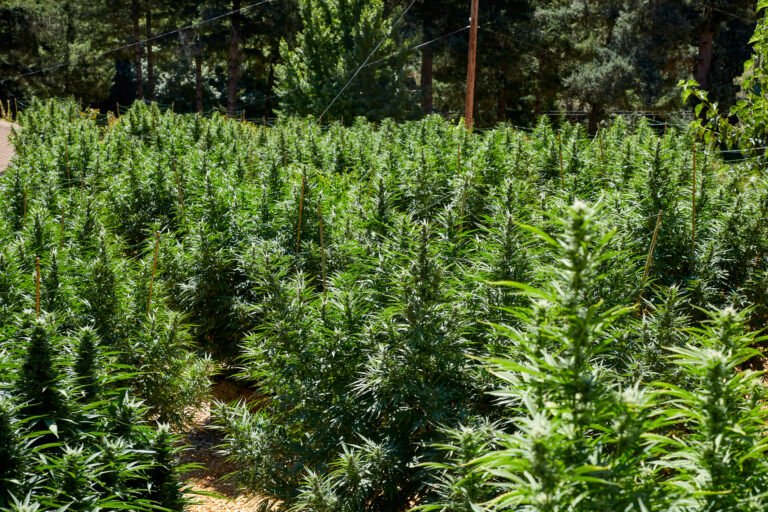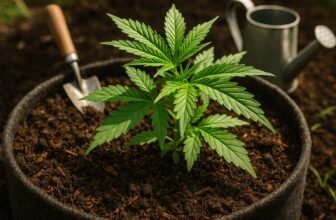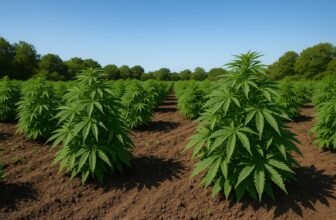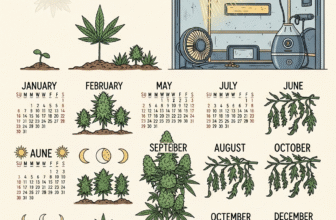
Planting cannabis 🌱 at the right time is one of the most important decisions a grower can make. Whether you’re cultivating indoors under artificial light or outdoors under the sun, the timing of when you sow your seeds directly influences plant health, growth speed, potency, and final yield. Too early, and your seedlings may suffer from cold weather or inadequate light. Too late, and your plants may not have enough time to flower fully before harvest.
Because cannabis is a photoperiod-sensitive plant (unless growing autoflowers), it reacts to seasonal changes in light and temperature. This means growers in different regions—like California, Canada, or Australia—must adjust their planting times based on local climate and daylight hours.
In this guide, we’ll walk you through everything you need to know about the ideal time to plant cannabis—indoors or outdoors, in the Northern or Southern Hemisphere, and for different strain types. Whether you’re a beginner or a seasoned cultivator, this information will help you grow stronger plants with higher-quality buds.
Understanding Cannabis Growing Cycles
To know when to plant cannabis, you first need to understand its life cycle. Cannabis goes through four primary growth stages, and each stage is affected by environmental factors such as temperature, light exposure, and humidity. Timing your planting properly means aligning these stages with optimal conditions for healthy development.
1. Germination Stage (3–10 days)
This is where it all begins. A cannabis seed cracks open and sprouts a taproot. You’ll know it’s ready for soil or a starter plug when a small white root emerges. This stage requires warmth (70–85°F or 21–29°C) and moisture, but not light.
2. Seedling Stage (2–3 weeks)
Once your sprout emerges from the soil, it enters the seedling phase. Small leaves (cotyledons) will appear, followed by the first true leaves with serrated edges. The seedling needs around 18–24 hours of light per day, low humidity, and a gentle airflow.
3. Vegetative Stage (3–8 weeks or more)
During this phase, cannabis plants focus on growing stems, branches, and leaves. Outdoors, this aligns with the long daylight periods of spring and early summer. Plants need more nutrients, especially nitrogen, and a stable environment.
- Photoperiod strains will remain in the vegetative stage until daylight decreases (usually after the summer solstice).
- Autoflowers, however, switch to the next stage automatically, regardless of day length.
4. Flowering Stage (6–12 weeks)
This is the reproductive phase where cannabis plants begin forming buds. It’s triggered by shorter daylight hours (or a 12/12 light schedule indoors). Outdoor growers must ensure flowering begins early enough before cold fall weather or frost arrives. Strain type (Indica, Sativa, hybrid) also influences how long this stage lasts.
5. Harvest
The final stage involves timing your cut perfectly to achieve the desired potency and effect. Harvest usually occurs between late September to October for outdoor grows in the Northern Hemisphere—but varies based on strain and location. Timing your planting so each phase aligns with the right conditions is essential for high-quality yields.
In the next section, we’ll break down what influences the best planting time.
☀️ Key Factors That Affect Planting Time
The ideal time to plant cannabis isn’t the same for everyone—it depends on several environmental and technical factors. Below are the most important considerations to help you determine the right planting window for your setup and location:
🌎 1. Climate Zone
Your local climate has the biggest impact on planting time, especially for outdoor growers. Frost, rainfall, and daylight hours all affect when it’s safe to start.
- Temperate zones: Wait until after the last spring frost (often mid-April to mid-May).
- Mediterranean zones: You can usually plant earlier (as early as March).
- Tropical zones: You may be able to grow year-round, but planting just before the dry season is ideal.
Use a frost date calculator or plant hardiness zone map to guide your planning.
🏡 2. Indoor vs. Outdoor Setup
Outdoor growers must work with nature’s calendar, waiting for stable temperatures and adequate sunlight. Indoor growers have the advantage of complete environmental control and can start growing any time of year, provided their grow room conditions are stable. Indoor growers can also start plants early indoors and transplant them outdoors once the risk of frost has passed.
🌱 3. Strain Type (Photoperiod vs. Autoflower)
Photoperiod strains depend on light cycles to enter the flowering phase. Outdoors, they should be planted after the last frost and early enough to ensure flowering starts before days get too short. Autoflower strains are time-based, not light-based. They grow quickly (from seed to harvest in ~10 weeks) and are great for short seasons or multiple plantings per year. Choosing the right strain can give you flexibility in when to plant.
🌡️ 4. Soil Temperature and Moisture
Even if the air feels warm, cold soil can stunt root growth and lead to slow development. Ideally, wait until soil temps are above 60°F (16°C) and not overly saturated from snowmelt or spring rains. Use a soil thermometer to check conditions before transplanting seedlings outdoors.
💡 5. Daylight Hours
Cannabis thrives with 14–18 hours of light during vegetative growth. Outdoor growers need to align planting time with increasing daylight hours in spring. In most regions, planting between mid-April to early June ensures enough light for strong vegetative development. By taking these factors into account, you can avoid the risks of poor timing—like slow growth, low yields, or crop loss.
Next, we’ll dive into exact planting timelines for outdoor cannabis cultivation.
🌿 When to Plant Cannabis (or marijuana) Outdoors?
Growing cannabis (or marijuana) outdoors can yield large, robust plants—but timing is everything. Planting too early risks frost damage and stunted growth, while planting too late may result in underdeveloped buds before the fall chill sets in. Here’s how to get it right.
Growing weed outdoors is a natural and cost-effective way to cultivate cannabis, taking advantage of sunlight, fresh air, and natural soil. To begin, choose a sunny, discreet location with well-draining, nutrient-rich soil. Select high-quality seeds suited to your local climate—preferably feminized or autoflowering strains for better yields and easier care. Germinate the seeds indoors, then transplant them outside after the last frost. With regular watering, pest control, and minimal nutrients, your plants can thrive and produce a rewarding harvest by late summer or early fall.
📅 Northern Hemisphere Planting Guidelines
In regions like the U.S., Canada, and Europe, outdoor planting typically occurs:
- Start seeds indoors: Late February to April.
- Transplant outdoors: Mid-April to early June, depending on your local last frost date.
- Flowering begins: Late July to early August.
- Harvest window: September to October.
Use this rule of thumb: Plant outdoors after the last frost and when nighttime temperatures stay consistently above 10°C (50°F).
Regional examples:
- 🌞 California: Late March to early May.
- 🍁 Canada (Ontario/Quebec): Mid-May to early June.
- 🌧️ UK: Mid-May for most southern areas; early June further north.
📅 Southern Hemisphere Planting Guidelines
In countries like Australia, South Africa, and parts of South America:
- Start seeds indoors: August to September.
- Transplant outdoors: September to November.
- Flowering begins: January to February.
- Harvest window: March to May.
Just like the north, make sure you’re past the last frost and the daylight hours are increasing.
🌱 Starting Seeds Indoors Before Outdoor Planting
A popular strategy is to germinate and grow seedlings indoors under lights for 2–4 weeks, then move them outdoors. This:
- Protects against cold snaps.
- Gives plants a head start in the growing season.
- Leads to bigger yields.
Pro Tip: Harden off your plants by gradually exposing them to sunlight outdoors for a few hours a day over a week before transplanting.
⚠️ Risks of Planting Too Early or Too Late
Knowing your local climate, frost dates, and strain type helps you plant at the perfect time for strong, healthy growth.
- Too early planting: Cold temps can kill seedlings or slow their metabolism. Shorter days can confuse photoperiod strains.
- Too late planting: Plants may not enter flowering early enough or won’t have time to produce full buds before autumn cold or rain.
In the next section, we’ll explore how indoor growers have more flexibility and how to take advantage of it.
💡 When to Plant Cannabis (or marijuana) Indoors?
One of the biggest advantages of indoor cannabis cultivation is the freedom to plant year-round. Because you control the lighting, temperature, and humidity, you’re not dependent on seasons or daylight hours. However, understanding timing is still essential—especially if you want to maximize growth, yields, and energy efficiency.
🕒 Indoor Growing Is All About Scheduling
With indoor setups, you can technically start planting any time of year. But your schedule should still follow the plant’s natural life cycle:
- Seed to harvest timeline: 10–16 weeks on average, depending on strain and goals.
- Autoflower: ~10 weeks.
- Photoperiod (from seed): ~14–18 weeks total.
- Light cycles:
- Vegetative stage: 18–24 hours of light per day.
- Flowering stage: 12 hours light / 12 hours darkness (for photoperiod strains).
Plan backward from when you want to harvest and time your planting accordingly.
🌡️ Environmental Conditions to Maintain
Even indoors, 4 necessary conditions need to be optimized:
- Temperature: 70–85°F (20–30°C) in veg, slightly cooler (65–80°F) in flower.
- Humidity: 65–70% in seedlings, 40–60% in veg, 40–50% in flower.
- Airflow: Fans and exhaust to prevent mold and heat pockets.
- Lighting: Full-spectrum LEDs or HPS lights depending on budget and size.
🧪 Best Times for Beginners to Start Indoors
While you can plant year-round, starting: In late winter or early spring mimics nature and is great if you’re planning to move plants outdoors later. In autumn or early winter, when ambient temps are cooler, can save energy on cooling systems and reduce pests.
🌱 Indoor Grow Cycles for Perpetual Harvests
This allows for continuous yields and makes efficient use of space and time. Indoor growers often create perpetual harvest setups by:
- Staggering plantings every 2–4 weeks.
- Using multiple grow tents (veg + flower rooms).
- Cycling photoperiod or autoflower strains.
While indoor cannabis growing gives you total flexibility, planning your grow cycle and managing conditions properly is just as important as timing. Up next, we’ll explore how strain type (autoflower vs. photoperiod) affects the ideal planting schedule.
🌿 Best Time to Plant by Cannabis Strain
Not all cannabis strains follow the same rules when it comes to planting time. The two main categories—photoperiod strains and autoflowering strains—have different biological triggers for growth and flowering. Knowing which type you’re growing helps you choose the most productive time to plant.
🌞 Photoperiod Strains
These strains require specific light cycles to transition from the vegetative phase to flowering. Outdoors, that shift happens naturally as days shorten near the end of summer. Indoors, it must be controlled with light timers.
Key traits:
- Remain in vegetative stage until light drops to ~12 hours/day.
- Usually yield higher than autoflowers.
- Take longer to grow—3 to 5 months from seed to harvest.
Best time to plant outdoors:
- Northern Hemisphere: Mid-April to early June (after last frost).
- Southern Hemisphere: September to November.
Best time to plant indoors:
Anytime, as long as the light cycle is managed:
- 18/6 light for veg.
- 12/12 light for flower.
⚡ Autoflowering Strains
Autoflowers bloom based on age, not light, making them ideal for quick harvests and growers in regions with short summers or unpredictable weather.
Key traits:
- Begin flowering automatically after ~3–4 weeks.
- Entire life cycle is short—8 to 12 weeks.
- More forgiving in terms of timing and light exposure.
Best time to plant outdoors:
- Northern Hemisphere: As early as late April or May (you can do 2–3 runs before fall).
- Southern Hemisphere: September to January.
- Plant every few weeks for succession planting.
Best time to plant indoors:
- Any time of year.
- Use 18–20 hours of light per day for best results (no need to switch to 12/12).
🌱 Hybrid Recommendations
If you’re a beginner or have a short growing season, autoflowers offer an easier and quicker solution. If you want bigger yields and have more time, photoperiod strains are more rewarding, especially when started early. Choosing the right strain type for indoor or outdoor cannabis cultivation not only affects your planting calendar—it also determines how much control you need to have over your growing environment. Next, we’ll present a regional planting calendar to help you pinpoint the best window to start growing based on your location.
📆 Region-Based Planting Calendar (Table Guide)
Your geographic location plays a huge role in determining when you should plant cannabis outdoors. Different climates have varying frost dates, daylight hours, and seasonal temperatures. Below is a region-specific calendar to guide you in planning the best time to plant cannabis outdoors.
| Region | Climate Zone | Start Seeds Indoors | Transplant Outdoors | Harvest Period |
|---|---|---|---|---|
| Northern US (e.g., Michigan, Oregon) | Temperate | March – April | May – Early June | September – October |
| Southern US (e.g., California, Florida) | Mediterranean/Subtropical | February – March | March – May | August – October |
| UK & Northern Europe | Oceanic/Continental | March – April | Late May – June | September – October |
| Southern Europe (e.g., Spain, Italy) | Mediterranean | February – March | April – May | Late August – September |
| Canada (Southern regions) | Cool Temperate | March – April | Late May – June | Late September – October |
| Australia (e.g., NSW, VIC) | Temperate (Southern Hemisphere) | August – September | September – November | March – May |
| South Africa | Subtropical | August – September | September – October | March – April |
| India (Himalayan foothills) | Subtropical to Temperate | February – March | March – April | September – October |
✅ Important Notes:
- Start seeds 2–4 weeks before transplanting outdoors.
- Watch your local last frost date: never transplant seedlings until nights are consistently above 10°C (50°F).
- Use autoflower strains for shorter seasons or second harvests.
- Soil temperature should be at least 60°F (16°C) for safe transplanting.
This planting calendar serves as a practical guide, but remember that local microclimates and weather patterns can vary even within a region. Always check your zone-specific frost dates and monitor soil and air temperatures before planting.
⚠️ 6 Common Mistakes to Avoid When Planting Cannabis
Even experienced growers can run into problems if they mistime or mismanage the early stages of cannabis cultivation. Here are some of the most common planting mistakes—and how to avoid them:
❄️ 1. Planting Too Early (Before the Last Frost)
Why it’s a problem: Cold soil and low nighttime temperatures can shock seedlings, stunt growth, or kill young plants altogether.
3 Steps to avoid it:
- Check your local last frost date before transplanting outdoors.
- Wait until nighttime temperatures stay consistently above 10°C (50°F).
- Start indoors and harden off plants before moving outside.
🕒 2. Planting Too Late
Why it’s a problem: Late planting shortens the vegetative phase, especially for photoperiod strains, leading to smaller plants and reduced yields.
2 Steps to avoid it:
- Aim to transplant photoperiod strains by early June (Northern Hemisphere) or November (Southern Hemisphere).
- Use autoflowers for late-season planting if needed.
🌱 3. Not Hardening Off Seedlings
Why it’s a problem: Indoor seedlings exposed directly to outdoor sun and wind can burn, wilt, or die due to sudden environmental shock.
How to avoid it:
- Gradually expose seedlings to outdoor conditions over 7–10 days.
- Start with 1–2 hours in filtered light and slowly increase exposure.
💧 4. Ignoring Soil Conditions
Why it’s a problem: Cold, soggy, or compacted soil hinders root development and may lead to root rot or nutrient lockout.
3 Steps to avoid it:
- Wait until soil reaches at least 60°F (16°C).
- Ensure good drainage and aeration.
- Avoid planting after heavy rains or snowmelt.
🌿 5. Using the Wrong Strain for Your Climate
Why it’s a problem: Some strains (especially sativas) take longer to mature and may not finish before cold weather returns.
2 Steps to avoid it:
- Choose autoflowers or fast-finishing indica or hybrid strains if your season is short.
- Research local grower forums for regional strain recommendations.
💡 6. Poor Light Management Indoors
Why it’s a problem: Without proper light cycles and intensity, plants can become leggy, stressed, or slow to flower. Avoiding these mistakes can mean the difference between a disappointing grow and a bountiful harvest.
How to avoid it:
- Use full-spectrum grow lights.
- Keep consistent light cycles (18/6 for veg, 12/12 for flower).
- Maintain the correct distance between lights and canopy.
In the next section, we’ll go over expert tips for maximizing yields by planting time.
🌾 6 Tips to Maximize Yield by Planting Time
Planting cannabis at the right moment is just the beginning—how you use that timing to your advantage can significantly boost your final yield. Here are pro grower strategies for getting the most out of your grow, based on optimal timing.
🌱 1. Start Seeds Indoors for a Head Start
Instead of waiting for outdoor conditions to improve, germinate seeds indoors 2–4 weeks before your target transplant date.
Why it works:
- Protects seedlings from unpredictable spring weather.
- Gives plants a stronger root system before outdoor stress.
- Extends vegetative phase for photoperiod strains = bigger plants.
🌞 2. Time Transplanting With Increasing Daylight
Outdoor photoperiod strains thrive when daylight is increasing (spring to midsummer). Transplanting when days are getting longer helps:
- Trigger strong vegetative growth.
- Avoid early flowering or stunted development.
Pro Tip: In most regions, this means transplanting after the spring equinox and before the summer solstice.
🌼 3. Use Autoflowers for Multiple Harvests Per Season
Autoflowering cannabis allows for succession planting:
- First run: Late April – Early July.
- Second run: Mid-July – Early October.
Why it works:
- Autoflowers finish in ~10 weeks.
- You can squeeze in 2–3 grows per season, especially in warm climates.
🏠 4. Extend Your Season With a Greenhouse
Greenhouses trap heat and protect against wind and rain, allowing:
- Earlier spring planting.
- Later fall harvesting.
- Protection from pests and frost.
You can start earlier and finish later than outdoor-only growers—plus extend the flowering window for photoperiods.
💨 5. Monitor Weather and Microclimates
Knowing your local conditions helps you act fast:
- Watch soil temperatures and weather forecasts.
- Consider south-facing slopes or raised beds for warmer soil.
- Use apps to track sunrise/sunset and UV index.
🪴 6. Choose the Right Container Size (or Ground Space) Early
Starting in a small pot and transplanting late can restrict root growth. If you know when you’re planting:
- Prep full-size containers or garden beds in advance.
- Give roots room to grow right from the start.
Result: Bigger root zone = healthier, taller plants = more buds.
❓ 9. Frequently Asked Questions (FAQs)
Generally, no—unless you’re growing indoors or in a heated greenhouse. Cold temperatures and low light levels in winter will stunt or kill cannabis plants. For outdoor cultivation, always wait until after the last frost.
If you’re growing photoperiod strains, you may still plant late spring to early summer, but yields may be smaller. If you’re too late, opt for autoflowering strains, which mature faster and can be grown later into the season.
Wait until your soil temperature is at least 60°F (16°C). This encourages root development and prevents stress.
Yes, but only if your climate is warm enough and you’re past the last frost. Most growers prefer starting seeds indoors to protect young plants from pests, cold, and wind.
Yes. Photoperiod strains need longer daylight and must be planted earlier. Autoflowers are more flexible and can be planted throughout the warmer months—even into late summer in some climates.
It depends. Indoors offers year-round growing and climate control but requires equipment. Outdoors is more affordable and natural but depends heavily on your local weather and season.
Photoperiod strains: 4–6 months total.
Autoflowers: 8–12 weeks from seed to harvest.
Photoperiod plants typically begin flowering after the summer solstice, when daylight hours begin to decrease—usually late July through August in the Northern Hemisphere.
Conclusion
Knowing when to plant cannabis is one of the most important steps in achieving a healthy, high-yield grow. Whether you’re planting photoperiod strains that rely on daylight changes or autoflowers that operate on their own timeline, timing your grow to match your environment makes all the difference.
For outdoor growers, this means understanding your local climate, tracking frost dates, and syncing planting with longer daylight hours. For indoor growers, it’s about creating the right conditions year-round and aligning light cycles with each phase of the plant’s life.
The right planting time can:
- Prevent shock from cold temperatures.
- Maximize vegetative growth.
- Improve flowering and bud development.
- Boost total yield and potency.
Take the time to plan your grow, know your strain, and work with nature—not against it. Whether you’re cultivating for personal use or a larger harvest, smart timing is the first step to success.
References and sources used in content creation:
- https://www.growbarato.net/blog/en/how-and-when-to-plant-marijuana/
- https://weedmaps.com/learn/the-plant/weed-seasons
- https://www.lahuertagrowshop.com/blog/en/when-to-plant-cannabis-seeds-outdoors/
- https://apotforpot.com/blogs/growing/cannabis-outside-state-by-state-guide/
- https://thebudgrower.com/best-time-to-grow-cannabis/
- https://ilgmforum.com/t/outside-growing-when-to-start-seeds-pnw/94019
- https://tankglass.com/blogs/tank-blog/when-should-you-grow-marijuana-outdoors-in-california






